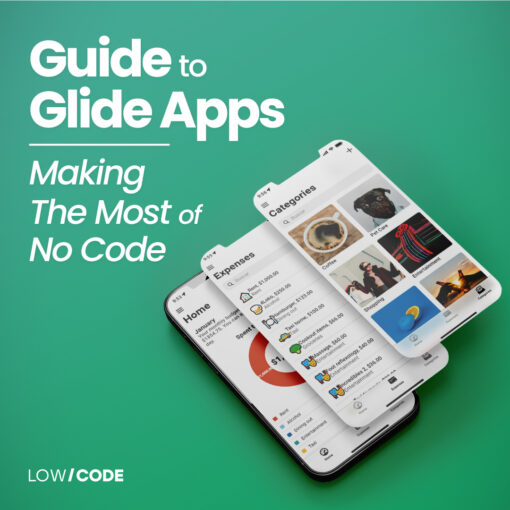From $2,500 to $100,000+
That’s how much a web app development project can cost you in 2021. It’s a huge gap, with costs rising mainly due to custom requirements and third-party integrations.
The traditional development costs of a web app are often astronomical, making them viable only for big corporations or really good developers with a lot of time on their hands.
But in 2023, a new way of development is emerging…
And it brings down web app costs significantly.
» TRY NOW: Estimate How Much Your Dream App Would Cost with a Simple Calculator
With software applications, you had no choice in the past but to either: 1) learn how to develop programs yourself, or; 2) pony up 100s of thousands of $ to create one from scratch.
It’s a proposition that most small businesses saw as impractical (if not impossible to achieve due to time and budget restraints), so what’s the cost of developing a web app today?
The 10 Major Cost Factors in Web App Development
A “web app” isn’t just a static thing, it could be a billion different things: one page with a rich database in the background, multiple pages for subscription services, and more.
There are 10 core elements you need to be aware of when talking about web apps in general and, more importantly, how much they will end up costing you:
- Overall size of the app based on pages to design and features to develop
- Type of User Interface elements and level of detail or customization
- Whether the app should support user signup and accounts
- Whether users are able to generate their own content
- If you’re planning to use date and location features
- Which social media integrations you need
- Whether and how you plan to bill users
- Any backend functionality required
- Third-party integrations and APIs
- Your security requirements
These are the 10 elements you need to know about and research to a good degree for a fully-informed decision on whether an app will cost you more than you can put in.
Don’t worry though, we’ll simplify things for you by giving a comprehensive breakdown of traditional web app costs versus how much it costs to create one in 2023.
Full Breakdown of Web App Development Costs

Recent developments in low-code/no-code technologies are bringing the overall cost of web app development down significantly, but building an application is still far from “easy.”
One of the things that people who want to outsource app development struggle with the beginning is coming up with a complete scope of their MVP, or Minimum Viable Product.
In some cases, it’s possible to go above and beyond when it comes to UI design and level of detail but only if the initial scope isn’t too vast or complex to handle.
The scope of an app (whether for web or mobile) can be boiled down to the 10 elements described above which, coincidentally, are also the major cost drivers.
In the sections below, find a full breakdown of the potential features for each element and a comparison between traditional web development and low-code/no-code development costs.
1- Initial App Size
Just like an executive summary in a business plan or an abstract in a research paper, a web app can be assigned a relative “size” based on all other factors in this list.

If you want your estimate to be accurate, you should go through the other factors first, and then come back once you’ve identified what size your app is:
- Small
- Medium
- Large
With previous development experience, you might be able to roughly estimate this but, in most cases, you’ll want to grab pen and paper and list out all the requirements.
The 3 App Sizes To Consider
A small web app is something that can do its job with ~5-6 page types, only a few of which have the most functionality baked in. This is an app that does one thing well and that’s it.
Medium-sized apps are more in tune with the needs of a small business: time scheduling for employees, organizing business assets, providing end-users with a web interface, and more.
Finally, large apps go beyond the needs of a small business and may turn into complex business solutions that require ongoing development and assistance.
In most cases, you will fall under the first 2 options but, sometimes, a large app is exactly what’s needed to get the job done (think about industrial processes or business infrastructure).
The costs related to the size of your app are more about total design and development hours rather than specific features. Here’s a table with approximate estimates of this:
| Traditional Web App Development Costs | Low/No-Code Web App Development Costs | |
|---|---|---|
| Small | ~$20000 | ~$2500 |
| Medium | ~$29000 | ~$4500 |
| Large | $50000+ | $6000+ |
Surprised about the huge gap?
Traditional web development costs almost 10 times more than low-code development in most instances, making the business case for the latter that much more appealing.
(And the trade-offs aren’t that big either!)
But this is just an umbrella view of how much you can expect to spend on your app in total, now we’re going to dive deeper into the specifics of your web app.
2- User Interface
Although not the starting point in a web app development project, the UI is certainly one of the aspects that you will care about the most as it will represent your company’s branding.
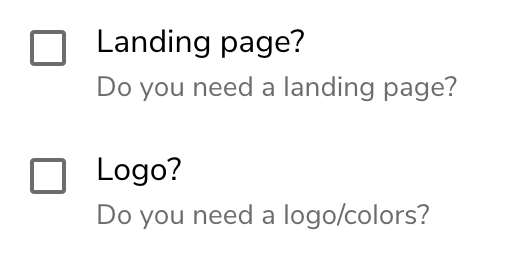
Depending on the level of detail and customization, UI can be one of the more cost-effective elements on one end, and an extremely expensive one on the other (fancy custom graphics).
How you choose to start with your UI is entirely up to you.
The reason why traditional development costs so much is often because of the creative needs added on top of the technical ones. With low-code, this isn’t as much of a problem.
Since most of the functionality is already built out and ready to be “slotted into” your application, low/no-code development allows for more resources to be allocated in UI.
Here’s a breakdown of what to expect:
| Traditional Web App Development Costs | Low/No-Code Web App Development Costs | |
|---|---|---|
| UI for small web app | ~$5000 | ~$500 |
| UI for medium web app | ~$9000 | ~$900 |
| UI for large web app | $17000+ | $1200+ |
Lowering costs in the UI department is all about making use of standardized “design blocks” that are then customized to fit your branding and style.
In traditional web development, this doesn’t happen, and if it does, it’s because the web designers have built their own library of standard blocks to use for customers.
Even then, slightly changing a block’s design via code instead of visually takes far more time than necessary, and is a big man-hour cost factor to consider.
3- Accounts
Today, account management is standard across most applications as best practices are in place to get the best of logging in and out of a system, lowering the overall price of implementation.
This is one of the areas where you’ll see the least expense as the development can be partially automated due to the functionality being almost always the same.
In traditional development, best practices are used in the native programming language to ensure that the login mechanism is secure and that data is stored correctly.
With low/no-code development, this is handled by the development provider themselves, meaning that there’s close to zero time spent on securing the environment.
For either small or large apps, you can expect similar costs:
| Traditional Web App Development Costs | Low/No-Code Web App Development Costs | |
|---|---|---|
| Accounts functionality | ~$2000 | ~$200 |
You can choose to have your app not offer any account functionality, saving you a bit of money in the process, but in most cases, businesses will need to track their app’s usage.
The only way to do that is to have people sign up for an account.
4- User-Generated Content
Unlike accounts, User-Generated Content (UGC) has a wide spectrum of uses that can vary from reasonable costs to astronomical ones depending on the complexity of implementation.

The biggest value software offers is allowing “normal” people to get faster and more productive at doing something, or to enhance their social interactions via unique content snippets.
That’s what UGC promises: a rich experience that can give users more than just a place to retrieve information but rather interact with it in their own way.
Facebook is a prime example of all things UGC as every aspect of it allows you to create snippets of content that are yours but, in most cases, you’ll need simpler things:
- File uploading
- Tags and labels
- Ratings and reviews
- Processing of imagery
… and more.
The sky’s the limit here.
You should spend enough time thinking about what types of UGC you want in your app because getting it wrong the first time can lead to much higher costs down the road.
Here are some estimates to help you frame the costs:
| Traditional Web App Development Costs | Low/No-Code Web App Development Costs | |
|---|---|---|
| Labels and tags | + $1100 | + $115 |
| Media uploading | + $1800 | + $150 |
| Ratings and reviews | + $2500 | + $400 |
Think about UGC functionality like options in a car: they may be essential to some but definitely not necessary for others. Choose wisely when presented with options!
5- Date & Location
Thanks to their standard formatting, dates, and location are quite easy to handle in the digital world, especially if you’re building out a “static” (no UGC) app for your local shop.

Displaying custom map markers can cost you as little as the time that it takes to list out the locations and correctly input the coordinates, then display the map on your app.
Geolocation is also cost-effective to implement. More complex functionalities like custom booking and calendaring come at the cost of providing the right scheduling options.
| Traditional Web App Development Costs | Low/No-Code Web App Development Costs | |
|---|---|---|
| Map markers | + $900 | + $120 |
| Geolocation | + $1500 | + $180 |
| Bookings | + $2750 | + $450 |
6- Social Media Integration
Utilizing Application Programming Interfaces (APIs) in traditional development environments is very complex and time-consuming due to the documentation changing from provider to provider.
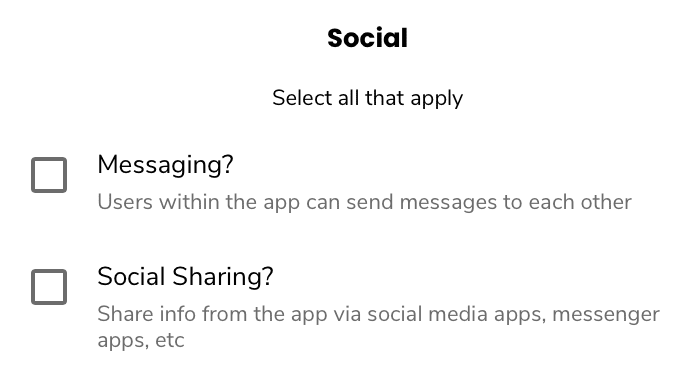
With low-code integrations, the most popular social media platforms will already be hooked up to the system. The only change will be what to share when integrated correctly.
Social media isn’t just for sharing though…
It can also be used to help people sign up and log in faster, offering a more premium and convenient experience compared to allowing just email login.
Sharing isn’t expensive to implement.
Pushing content natively is another story.
A share is a simple link being sent out to your social account with some additional information, ready to post. A native upload requires deep access to the social API instead.
| Traditional Web App Development Costs | Low/No-Code Web App Development Costs | |
|---|---|---|
| Social sharing | + $900 | + $115 |
| Native uploads | + $3000 | + $600 |
NOTE: Some low/no-code platforms don’t allow for native uploads yet so this often requires personalization unless you’re using the most popular platforms like Facebook and Twitter.
7- Payments & Billing
The last 4 entries in the list are where things start getting more technical (i.e. more development time!), starting from direct payments and billing from the app.

The standardization problem in this area is (thankfully) solved by Stripe, a payments gateway that is used across most web applications today. Without it, billing would be a big mess.
Thanks to this wonderful service, the costs of implementing billing features such as subscription plans, eCommerce functionality, payment processing, and more are ok to handle:
| Traditional Web App Development Costs | Low/No-Code Web App Development Costs | |
|---|---|---|
| Billing and payments | ~$4200 | ~$540 |
If you allow payments, this is one of the big areas of your app’s experience, you don’t want to skimp on this as it’s what’s going to drive return on investment when you release the app.
8- Backend Functionality
This is where you’ll want to pay particular attention when first planning out the scope of your application. Most of the backend stuff will relate to what’s on the frontend for the user.
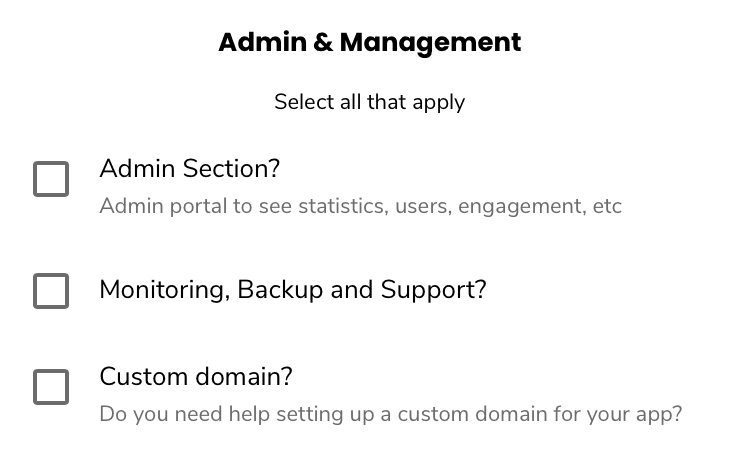
If you’re building out an amazing web app that does great things for the end-user but you don’t know how they’re using it in the first place, there’s not much value in it.
That’s where you’ll want to implement things like:
- Content management systems
- Moderation and approval
- Performance monitoring
- Analytics for usage
- Crash reporting
… and more.
If you’re looking to build complex business solutions, the developers will start tackling this stuff first, and it will cost you more than any other element in this list.
Why? Because they’re hard to standardize.
Businesses often need different sets of data to leverage.
For example, a small local barbershop might not care about whether a customer likes to travel a lot but rather how many times they get their hair done every month.
This type of data implementation can only be done on a per-need basis, and it’s the reason why custom CRMs are so expensive; it just takes forever to develop the workflows necessary.
Don’t make the mistake of going “balls-to-the-walls” here. Instead, think rationally about what types of data your business will need the most when first starting out:
| Traditional Web App Development Costs | Low/No-Code Web App Development Costs | |
|---|---|---|
| CMS Integration | + $3000 | + $450 |
| Usage analytics | + $1600 | + $250 |
| Monitoring | + $900 | + $120 |
9- Third-party Integrations
Another tricky implementation is working with integrations that aren’t your typical Facebook, Twitter, etc. These will almost always require some degree of custom development.

For example, if you need your app to connect to QuickBooks for accounting purposes, it’s not super straightforward to get them hooked up in a way that’s cost-effective.
Connecting to a custom API will run you around $4K in additional costs for traditional development, and won’t always be possible with low/no-code development.
(Unless you’re using services like Zapier to port the data)
Before you decide on functionality that relies on third parties, check with your development provider that it is possible to pull or push data to them without problems.
| Traditional Web App Development Costs | Low/No-Code Web App Development Costs | |
|---|---|---|
| Custom APIs | + $4000 | + $700 |
10- Security Requirements
Security is a huge part of any information system, whether it be native or built with no-code applications. You can’t risk losing your user’s data when they invest time in your app.
We always recommend running data backups with your app as they’re fairly inexpensive, and we also recommend giving users the option to choose two-factor authentication.
Apart from this, most security features in low-code development are standardized, meaning they won’t cost you much at all. With traditional, best practices are put in place.
| Traditional Web App Development Costs | Low/No-Code Web App Development Costs | |
|---|---|---|
| Data backups | + $300/mo | + $150/mo |
| Two-factor auth | + $1900 | + $350 |
The more you get acquainted with the inner workings of a web app, the more you’ll be able to predictably estimate how much it will cost you to develop a good one.
While some upfront research is required for this to happen, the sections above are detailed enough to cover 90% of the use cases, especially for small businesses.
To get your foot in the door without any commitment, use the cost calculator linked in the image below to see what your dream web app would cost and whether it makes sense to build it.
Or schedule a discovery call here!
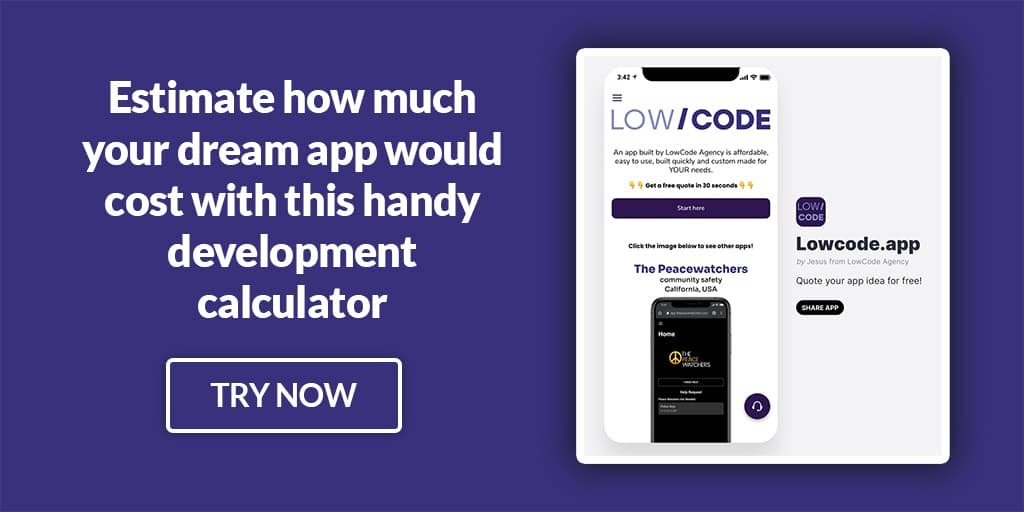
Frequently Asked Questions
A fully-fledged web application can cost anywhere from $2500 to a whopping $100K+ depending on your needs. A good way to drive costs down significantly is to use low/no-code technology instead of traditional development tactics which require many more man-hours.
Yes. The rise of low- and no-code technologies allow app developers to cut costs significantly thanks to pre-made functionality and customizable design elements. There’s no need to build everything from scratch in 2021 as most of the core functionality of each app will be the same.
Yes. No matter whether you use a no-code platform or you decide to build your app by coding it, it’s still not a 1-day task. You can’t approach it as if it was an essay, there are multiple steps to consider in the process. You will find most elements needed to build an app in this blog post.
It depends. If you’re willing to spend time learning programming (1000s of hours!) or low/no-code tools (100s of hours), then yes, it is possible. But if you’re looking for the most efficient way to get started, relying on a third-party developer is a great alternative, especially at today’s costs.

Jesus is the founder of Low Code Agency: a low-code development agency that allows small business owners to get their mobile and web apps done fast and cost-effectively while maintaining quality.


